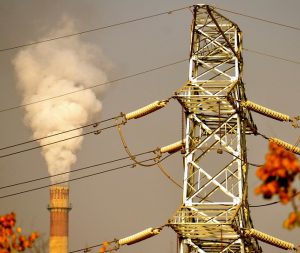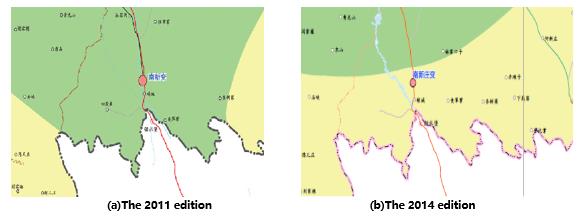Beginning in the 1970s, the Chinese power system experienced a growing number of massive outages triggered by pollution flashover. In fact, between the mid 1980s and 2006 alone, there were 44 large-scale outages linked to progressively worsening air quality across the country. For example, there were extensive pollution flashover outages in East China at the beginning and end of 1989, in North China at the start of 1990 and in East and Central China at the end of 1996. All these caused great economic losses and served as a powerful lesson of what can go wrong.
In order to assure a safe and reliable power supply, eliminating these flashovers became an urgent priority for the power sector and the best way to achieve this was by researching and properly classifying pollution levels in different service areas to assure that insulation is always dimensioned for the types of environmental stresses it will experience.
This edited 2016 contribution by Su Zhiyi of the China Electric Power Research Institute (CEPRI) explained how this task was accomplished and why China’s pollution map for its power grid, created based on long-term determinations of parameters such as ESDD and NSDD, came to be considered among the best such documents anywhere. Indeed, analysis of recent operating statistics at the State Grid Corporation of China and the China Southern Power Grid shows that pollution flashover accidents have been dramatically reduced. In fact, incidence of tripping caused by pollution flashover is much lower than from lightning, icing, birds, wind and wildfires.
Background
The first technical document “Outdoor insulation pollution classification of power plants, substations and overhead lines” was issued in 1979. The concept of ESDD was later incorporated into this document after several years’ experience collecting such data. According to service experience from the 1950’s to the 1970’s, the first official standard was issued in 1983 by China’s Ministry of Hydraulic and Electric Power, “Outdoor insulation pollution classification standard of porcelain insulation for high voltage overhead line and substations”. Pollution level was evaluated by measuring annual ESDD, looking at the characteristics of pollution and wetting and reviewing past operating experience. Among these factors, actual pollution flashover incidents given different levels of insulation proved the most valuable.

CLICK TO ENLARGE

Another large-scale power outage caused by pollution flashover occurred in North and Northeast China in February of 1990 and this incident prompted China’s power sector to devote even more attention to resolve this problem. The country’s first national standard (GB/T 16434-1996) “Environment pollution classification and outdoor insulation selection and dimensioning for high voltage overhead line, power plant and substation” was subsequently issued in 1996. But this document specified that overhead lines must still be cleaned once a year and substations every time they were de-energized. Moreover, the methodology to evaluate pollution level in this standard was still based only on annual ESDD measurements.
Later that same year, repeated large-scale, inter-provincial pollution flashover accidents occurred across Eastern and Central China. It was from that point on that a key lesson was learned: preventing pollution flashover by requiring frequent manual cleaning of insulators was insufficient and no longer belonged in the country’s standards. In addition, there was also recognition that levels of air pollution could not be reduced over a short time and, if anything, would only probably worsen. At the same time, given the country’s rapid pace of industrialization and economic development, it was clear that these types of incidents would have to be reduced substantially given short-term plans to greatly increase the numbers of overhead lines, construct new DC lines and continually upgrade transmission voltage levels. But achieving this required establishing the actual pollution situation affecting each service area as well as how these pollution levels were changing over time. This would be the only way to suitably dimension outdoor insulation. Based on this need, in 1998 China EPRI, Tsinghua University and many local institutes began a process of extensive research that took more than 10 years.
Evaluating Pollution Levels for AC Systems at SGCC
Work performed at China EPRI, Tsinghua University and elsewhere was supported by the State Grid Corporation of China and allowed the SGCC to issue its enterprise standard Q/GDW 152 “Pollution classification and external insulation selection for electric power system” in 2006. The basic principle put forward in this document was that dimensioning of insulators was to be independent of any requirement to clean them and that there would also have to be an additional safety margin as well. Moreover, a pollution classification methodology based on the relationship between SPS and ESDD/NSDD was also provided in this standard (see Fig. 2).

CLICK TO ENLARGE
In order to realize the goal of ending the traditional link between expected insulator service performance and mandatory annual cleaning, it was seen as necessary to study the ‘pollution saturation period’ across different regions of the country. For example, it was found that this period is about 3 to 5 years in the North but closer to 3 years in the South due to more abundant rainfall. Moreover, in regard to different types of pollutants, NSDD/ESDD ratios across the country were found to vary from 10:1 to 2:1. This range was considered representative for most of China and an average ratio of 5:1 was eventually selected. Fig. 3 shows the relationship between SPS and NSDD/ESDD in Q/GDW 152-2006, where both ESDD and NSDD are the long-term saturated pollution measured on a non-energized, standard cap & pin porcelain reference insulator. This figure differed from that used in the original draft of IEC 60815 but the formalized standard IEC 60815-1:2010 later saw its pollution classification slope modified, based on comments from China.

CLICK TO ENLARGE
Compared with IEC 60815-1:2010, Q/GDW 152-2006 took account of pollution distribution as well as diameter of pollution particles. At the same time, the document provided acceptable pollution flashover trip-out rates for transmission lines having different voltage levels. This requirement was tightened significantly in the recently revised version (Q/GDW 152-2014).
Development & Revision of Pollution Distribution Map at SGCC
In 1983, regional power grids, e.g. Beijing Grid, prepared their own pollution distribution maps based on annual ESDD measurements. Important technical documents were issued in 1990, 1996, and 2006 and these helped provincial grids to further refine regional pollution distribution maps.
Based on the concept of long-term saturated SPS requirements (ESDD and NSDD) stated in Q/GDW 152-2006, in 2011 the SGCC issued a pollution distribution map covering all China (see Fig. 4). This was the first time that such a map had been developed for the entire power grid and based on a common set of technical requirements. This map was revised in 2014 and will be updated once more whenever further revision is seen as required.

CLICK TO ENLARGE
Meteorological information and environmental pollution parameters and levels both had to be collected and analyzed as part of the work to create this map. Moreover, all existing overhead lines and substations also had to be identified. These requirements are described in Fig. 5 while the basic data collection principles are shown in Fig. 6. For example, among the key parameters collected as meteorological data were number of days with drizzle or fog and also their annual distribution. Prolonged periods without rainfall during a pollution accumulation cycle were also taken into account. Environmental pollution parameters included pollution type, distribution and number of pollution emitting sources. Consideration was even given to local forecasts of economic development as well as the expected impact on air pollution. Finally, long-term pollution data and past history of pollution flashover accidents were also analyzed.

CLICK TO ENLARGE

CLICK TO ENLARGE
Samples of meteorological charts are shown in Figs. 7 and 8. For example, average distribution of fog days in Hubei Province and average distribution of successive days without rain in Jiangsu Province (from September to December 2010) are shown in Figs. 7 (a) and (b) respectively. The chart of pollution sources and SPS monitoring sites are shown in Fig. 8.

CLICK TO ENLARGE

CLICK TO ENLARGE
Since 2002, monitoring of long-term ESDD and NSDD saturation has been gradually applied to the entire SGCC grid. Over 10,000 monitoring points were used each year starting in 2007 and, by the end of 2011, more than 1.2 million measurements had been collected. Data collection then continued and allowed for any revisions needed in the pollution distribution map by 2014. Given all the complexity and dispersion of findings when measuring pollution, any ‘abnormal’ data were removed to facilitate the process of developing statistics (see Table 1).

CLICK TO ENLARGE
Three main types of adjustments were found necessary when updating China’s pollution distribution map, as illustrated by the following cases:
Case 1: Adjustment of the local pollution map for Chongqing between 2011 and 2014 is shown in Fig. 9. The localized pollution level affecting the Chongqing Grid near the Changshou-Yanjia Chemical Industrial Zone was revised upward from class ‘d’ to class ‘e’ for two reasons. The first was increased pollution sources and the second reason was perpetual fog. Based on this, SPS data collected from pollution measurement points within the industrial zone showed it to be closer to level ‘e’. (Note: Relationship between color and pollution class is same as in Fig. 4).

CLICK TO ENLARGE
Case 2: Fig. 10 illustrates adjustment in the pollution map based on emissions from a coal-fired power plant in the Taiyangshan mountainous area. Reduction in original construction plans and scale of this facility resulted in a downward revision of local pollution level to class ‘d’.

CLICK TO ENLARGE
Case 3: The Northwest Power Grid was faced with a combination of increasing industrial and natural pollution sources. One reason was movement westward by heavy industry including coal, chemical, smelting and mineral processing factories. Another was heavy natural pollution coming off a salt lake and scattered across the region by periodic dust storms.

CLICK TO ENLARGE
Compared with the first edition of the local pollution map made in 2011, areas classified as class ‘a’ and class ‘b’ increased by 0.5% and 2.2% respectively in the 2014 edition. Similarly, the proportion of areas designated class ‘c’, ‘d’ and ‘e’ increased by 0.77%, 1.28% and 0.7% respectively. For example, increased severity to class ‘c’ could have come about from decreasing pollution in originally class ‘d’ designated areas or from increasing pollution in originally class ‘b’ designated areas. All five pollution classes therefore needed revision and this reflected changes in atmospheric pollution as well as in the level of local industrial activity. Indeed, the current pollution maps for typical regions of China (Fig. 11) show that the pollution situation in the Northwest (11a) is much more severe than in Central Provinces (11b and 11c).

CLICK TO ENLARGE
Developing Pollution Levels for DC Systems
DC has also been added into China’s pollution classification standard Q/GDW 152-2014. The most obvious point of difference versus the AC standard (Q/GDW 152-2006) was the reference insulator being used. Here, an anti-fog type disc was chosen since this is more typical of the DC system insulators used in China. Moreover, since silicone rubber (SR) composite insulators are now widely used on DC transmission lines, a composite long rod with alternating sheds was selected as another reference insulator. Another important change compared to AC is the location where DC reference insulators are placed on HVDC lines and at converter stations. Now, the positions are in both high and low electric fields and all reference insulators are located within the DC field. After allowing 3 to 5 years of pollution accumulation, saturated ESDD and NSDD levels are measured.

CLICK TO ENLARGE
DC pollution severity is divided into 4 classes, expressed in capital letters: A, B, C and D. In the case of the porcelain anti-fog insulator, the division point in ESDD between class ‘A’ and class ‘B’ is 0.05 mg/cm2 at the line where NSDD/ESDD = 6. The ESDD dividing point between class ‘B’ and class ‘C’ is 0.08 mg/cm2 and 0.15 mg/cm2 for class ‘C’ to class ‘D’ – both at the line NSDD/ESDD = 6 (see Fig. 12).
Another way to determine DC SPS is through calculation by multiplying the AC SPS by a DC/AC ratio ‘K’. The determination process for K (which usually falls in the range 1.2 to 1.8) is as follows:
(1) Measure SPS on an anti-fog DC reference insulator energized with DC stress or within the DC field to obtain SPS1;
(2) Also measure SPS on a standard disc AC reference insulator energized with DC stress within the DC field at the same location and over the same period of a few years to obtain SPS2;
(3) K=SPS1/SPS2.

CLICK TO ENLARGE
Impact on Preventing Pollution Flashover Outages
In order to prevent large-scale pollution flashover outages, three types of measures were conducted in past decades. The first was long-term onsite pollution severity measurement on different kinds of insulators in different regions. A pollution classification map was thereby created in 2011 and revised in 2014. Second, an artificial pollution test was developed to simulate the flashover process under natural pollution in all key aspects, i.e. chemical composition of the pollution, levels of soluble and non-soluble salts, and coefficients to reflect different insulator profiles. Finally silicone rubber composite insulators with reliable long-term electrical and mechanical performance were applied widely on overhead lines. At substations, improved RTV coatings were applied.
Through these various initiatives, the overall impact on preventing pollution flashover accidents in China has been extraordinary. In spite of continuing severe environmental pollution over the past decade, large-scale pollution flashover outages have been successfully eliminated. For example, the trip-out rate caused by pollution flashover dropped significantly from 0.12/100 km/yr in 2001 to only 0.001/100 km/a in 2014 (see Fig. 13).

CLICK TO ENLARGE
Conclusions
A new pollution classification method was put forward in China and a pollution distribution map created based on this work. A great deal of effort went into work to establish the equivalence of pollution properties and corresponding flashover testing. After the pollution distribution map was created, insulators were properly dimensioned based on data from pollution withstand voltage tests. Moreover, high quality silicone rubber composite insulators and improved RTV coatings were developed and applied widely across China’s power system. With these three key elements having been achieved, past frequent large-scale pollution flashover outages were effectively prevented and trip-out rate from pollution flashover in China has been sharply reduced.


















